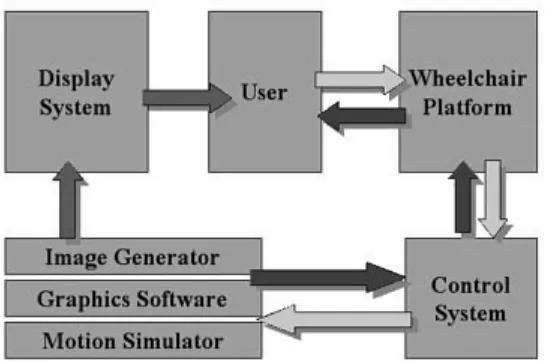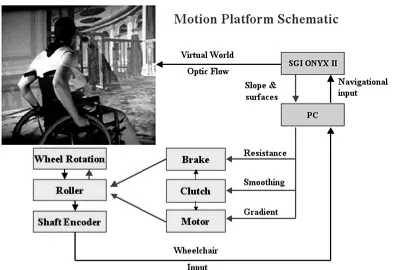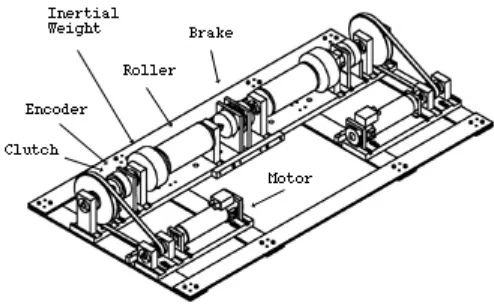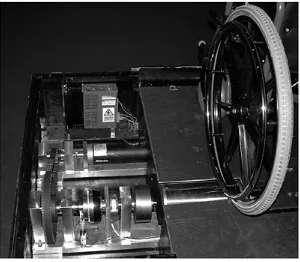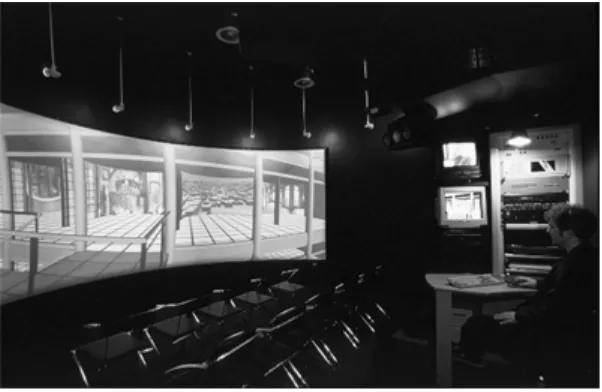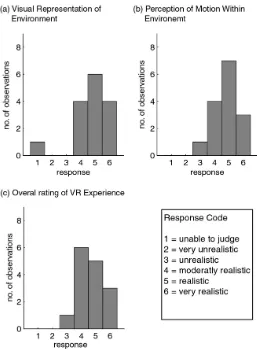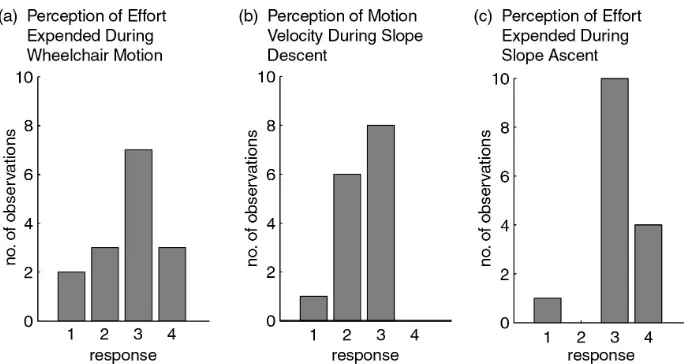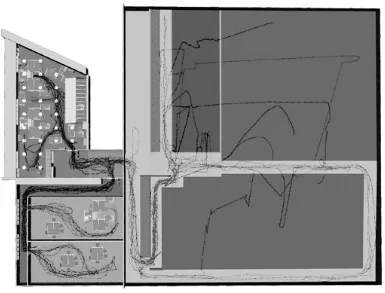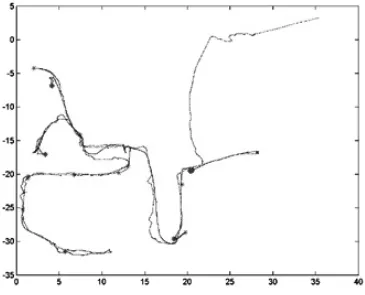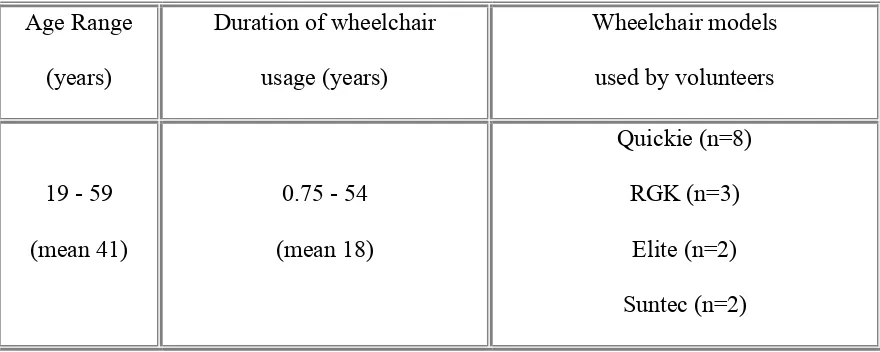Haptic Interfaces for Wheelchair Navigation in the Built Environment
Abstract
Many countries have recently introduced legislation aimed at ending discrimination against disabled people. In the UK, the Disability Discrimination Act (1995) provides the disabled community with new employment and access rights. Central to these rights will be an obligation for employers and organisations to provide premises which do not disadvantage disabled people. Many disabled people rely on wheelchairs for mobility. However, many buildings do not provide conditions suited to wheelchair users. This work reports on the development of instrumentation that allows wheelchair navigation within virtual buildings. The provision of such instrumentation assists architects in identifying the needs of wheelchair users at the design stage. Central to this project is the need to provide a platform which can accommodate a range of wheelchair types, that will map intended wheelchair motion into a virtual world and that has the capacity to provide feedback to the user reflecting changes in floor surface characteristics and slope. Integrating, visual and non-visual sensory feedback that correlates with the physical effort of wheelchair propulsion augments the perception of self-motion within the virtual world and creates an effective instrument for use in the study of wheelchair accessibility within the built environment. The project represents a collaborative effort between architects, bioengineers and user groups and research related to platform design, construction, interfacing, testing and user evaluation are presented.
Keywords:
• Virtual Wheelchair Access,
• Disability,
• Discrimination,
• Motion Simulation,
Haptic interfaces for wheelchair navigation in the built environment (2004) CS Harrison, M Grant, BA Conway
• Building,
• Instrumentation.
• Perception of effort Introduction
Over the last 30 years there has been an increasing awareness of the lack of provision of rights for people with disabilities and this has led to the introduction of a number of important legal devices. For example, in the USA the Americans with Disability Act (ADA)
(http://www.usdoj.gov/crt/ada/adahom1.htm/) has introduced legislation aiming to end the discrimination in education, employment, access to public and private accommodation and transport faced by the disabled community. Similarly, in the United Kingdom the Disability Discrimination Act (1995) (http://www.disability.gov.uk/dda/) has begun to phase in legislation that by 2004 will require service providers and employers to make reasonable adjustments to the physical features of their premises in order for disabled people to overcome physical barriers to access.
this significantly limits the standard and quality of living achieved by many individual wheelchair users. Adoption of inclusive design together with the enforcement of current legislation should offer equal opportunities for disabled people and through their full
integration in society lessen social security and welfare cost. Accordingly, there are important social and economic reasons for the development of tools, which could allow architects and others to explore access issues early in the design process of new buildings or in the
redevelopment of existing domestic and commercial building stock .
Virtual reality (VR) simulations of the built environment may provide the basis for such tools through accurate visualisation and user interaction. However, to capitalise on the potential for using VR as a tool to improve building accessibility it is vital that navigation through the VR world should be driven by systems that accurately reflect the mode of transport used by intended users. Immersion in VR systems is principally generated by optic flow driven by a navigation device. However, as wheelchair accessibility is constrained not only by the architectural layout of an environment but also by the physical features of the ground that the chair is moving across it is apt that VR environments designed for assessing wheelchair access should provide non-visual sensory feedback to the user that relates to the effort associated with propelling a wheelchair over changing terrains.
as ground conditions change. Implementing a haptic interface that achieves this would insure that the physical effort of propelling a wheelchair in the virtual world is matched with
expectations learned through actual wheelchair usage. For experienced wheelchair users presence within the virtual world will be enhanced if the integration between visual and proprioceptive feedback mechanisms are matched to expected outcomes of the users acquired motor behaviour. Accordingly, we report here on the development of a haptic interface which allows wheelchair users to navigate within VR simulations of buildings through the use of their own wheelchair and which provides the user with visual and proprioceptive feedback that directly relates to the task of wheelchair propulsion and control. The paper presents an outline of the development of the haptic wheelchair interface, its integration within a virtual reality laboratory and the results of a wheelchair user group evaluation on its use. The incorporation of haptics into VR simulations of the built environment provides a powerful tool that should allow wheelchair users to directly participate in the design and testing of accessible environments.
System Overview
The entire system is comprised of three mutually inter-linked components;
• the motion platform
• the graphics system
• the control system
Each of the above elements forms a linked system that is controlled by the bidirectional flow of information from the wheelchair to the virtual environment, and from the virtual
progress through the virtual environment and by the perceived effort associated with alterations in the rolling resistance of the wheelchair.
<Figure 1 near here>
By closing the feedback loop with a human rather than a further pair of sensor connections, it was found that any minimal latency or hysteresis in the rest of the communications path can be compensated for by the user.
Motion Platform
The design of the interface between the manual wheelchair and the virtual
environment has been specified so that the wheelchair remains fixed in place, with movable driving wheels. In this way the user is not limited within the virtual environment by the constraints of their physical environment. This interface was required to fulfil two main functions.
• Firstly, it had to be able to transfer the rotation of the driving wheels to provide realistic navigation around the virtual world ( REF Hofstad and Patterson, 1994,).
• Finally, in order that a user could retain their own wheelchair whilst navigating in the virtual environment, the interface has been designed to accommodate a wide range of manual wheelchairs.
<Figure 2 near here>
The physical structure of the wheelchair platform is based around a pair of rollers. These are mounted on separate shafts so that one roller is under each driving wheel of the wheelchair. The rollers are 300 mm long so that a range of wheelchair widths can be supported. The roller shaft is supported by a pair of single row radial ball bearings mounted in support pillars, fixed to a solid base plate. The roller, and space for an inertial mass, is situated between the two bearings. The maximum size of the mass that could be accommodated was a cylinder 65mm long with a diameter of 240mm. Outside the lateral ball bearing, the shaft was machined to accommodate a hollow shaft encoder. The body of the encoder is held with respect to the base plate, while the hollow shaft has been clamped to the roller shaft. Brakes are rigidly mounted coaxial to the roller shaft. Motors are geared to each roller shaft using a toothed belt and coupled through an electromagnetic clutch.
The disposition of these components is shown in Figure 3.
<Figure 3. near here>
The entire structure is enclosed by a wooden cover so that the user is protected from the moving parts. Two rectangular holes in the cover allow the rollers to stand slightly proud of the surrounding surface allowing wheel contact. Adjustable straps and bars ensure that the wheelchair is rigidly held in place on the rollers, and a ramp allows the user to gain access to the facility.
Note from Figure 4 the size and strength of the base plates and shaft supports required to bear the weight of the user and wheelchair when transmitted through a small contact patch.
Graphics System
The role of the graphics system is to generate a virtual world that can realistically represent the built environment both visually and physically and so provide feedback along two separate paths.
Visual Simulation
The virtual environment is visualised using a three-projector system that provides a 150 degree by 40 degree, high resolution image on a five metre diameter cylindrical screen. Each of the three image channels is edge blended to provide a seamless display. When viewed from the design eye point the image fills most of the users field of vision providing a highly
convincing sense of visual immersion within the scene as indicated by the results of our user evaluation (see Figure 6 and related text) . Graphics are generated on a twelve- processor Silicon Graphics ONXY II with two graphics pipes. This is capable of processing detailed architectural models at high frame rates in order to provide the desired degree of realism. At each time-step in the simulation the graphics are rendered to three separate output channels, each channel sharing the same eye point but with a different angular offset in azimuth, corresponding to the offsets in the projection system. This circumvents the geometrical distortion inherent in large field of view displays.
<Figure 5 near here>
The software used to drive the virtual environment is based on the Silicon Graphics Performer API. This is a high performance 3-D rendering toolkit for multiprocessed interactive
that interfaces between the incoming data from the motion platform control system and the rendering software.
Physical Simulation
The graphics application requires the Cartesian co-ordinates of the eye point, plus the yaw, pitch and roll angles of the direction of view. Given the yaw angle the remaining two parameters can be calculated based on the wheelchairs attitude on the floor plane. In the database traversal three rays corresponding to the contact patch of each of the rear wheels and the midpoint of the front axle, are intersected with the floor. The normal vector of the ground plane at these points can then be used to calculate the roll, pitch and altitude of the chair and hence the corresponding view. The same intersection procedure can also be used to identify the surface under each wheel, this information then being used to index material properties, such as rolling resistance and surface texture which can be passed back to the control system. Because the system does not support object to object collision detection a further class of intersection appraisal was implemented. This provided a matrix of randomly "jittered" rays aligned with the current direction of motion which proved to be capable of detecting collisions between the wheelchair and even relatively narrow vertical or horizontal
obstructions. The length of these rays was varied according to the distance traversed by the wheelchair between frame updates. On detecting a collision condition a flag is also passed back to the control system.
Control System
Motion Simulation
As outlined previously, the motion simulator and the graphics software form a closed loop system. . The motion simulator communicates with the graphics system over a TCP/IP network. The task of the motion simulator is to accept incoming data from wheelchair
platform, this data relating to the individual incremental angular displacement of both wheels on the motion platform. The current data values are compared to the previous increment, to determine whether either wheel is rotated forward or backward, this information then being passed to the next stage of the algorithm. The basis of the motion control algorithm is the determination, through an analysis of similar triangles, of any translation and also, using the location of the centre of rotation along the rear axle of the virtual wheelchair, the angle through which is turned. These values are passed to the graphics system where the transformation of the eye point and rotation of the view vector can be determined. As the angular motion of the rollers is used to calculate wheelchair displacement the motion of the visual field can be calibrated in relation to actual displacement. Feedback from the graphics system determines whether the brakes, clutch or motors should be actuated to provide a physical level of feedback to the user.
Platform Control
The motors are independently controlled for each wheel by setting suitable voltages on the motor control unit, this can be achieved by using the GPIB card and controlled via the software drivers. Thus control of the entire wheelchair platform is accomplished at the physical level by simply writing values on the GPIB card which are generated by software logic controlled by events in the virtual world. Since the user controls the position of the chair in the world realistic force feedback is provided by the actions directed to the platforms rollers.
Ascending and descending a steep gradient.
block to the platform generates an audible event that also indicates a collision event. The user therefore sees, feels, and hears collision events.
User Evaluation
Fifteen volunteer manual wheelchair users were recruited to participate in an evaluation of the interface. The evaluation was conducted with the approval of the University of Strathclyde Ethics Advisory Committee and written and informed consent was obtained from each participant. All volunteers were people with spinal cord injuries affecting their lower limbs and were considered to be experienced users of manual wheelchairs Summary details of the volunteers and the type of wheelchair used by individuals is given in Table 1.
<Table 1 near here>
In evaluating the system volunteers were asked to navigate around the VR model described previously and on completion were asked to rate how realistic various features of the
simulated environment compared with ‘real life’ experiences/expectations. This was done via a questionnaire which allowed a range of features relating to the performance of the
wheelchair platform, the sensation of self motion within the VR model and the degree of effort expended in navigating the virtual world to be assessed. Table 2 gives a summary of the areas assessed by the questionnaire and provides a key to the rating scales used in the
response to individual questions.
motion sickness the subject indicated that he often became ill during car, train and boat journeys. However, the remaining 14 subjects reported no incidences of motion sickness and their feedback from the questionnaire provides an important pointer to the performance of the system.
<Figure 6near here>
Figure 6 illustrates the user responses to questions relating to the integration between the wheelchair interface and the visual representation of the built environment (row 1 of Table 2). Importantly, the majority of users reacted positively to the system and rated both the
visualisation of the built environment and the perception of self-motion within the virtual world to be realistic.
<Figure 7 near here>
kerbs are rated less realistic than those in which the visual and non-visual sensory cues are matched. For example, features that utilise haptics such as changes in floor surface(Figure 7e), changes in slope (Figure 7g,h) and collisions (Figure 7i) are all considered as realistic and it is the combination of the sense of effort experienced by the user together with an
accurate visual representation of expected motion that provides the perception of reality and is a vital component in making the overall VR simulation truly immersive. This is further
emphasised in Figure 8 which shows the response to a series of questions relating to the level of physical effort needed to navigate through the simulation of the built environment,
<Figure 8 near here>
Based on the responses to the questionnaire illustrated in Figures 6-8 we believe that the developed interface can provide an important tool for examining access issues within simulations of the built environment. The system also has the ability to provide quantitative information on the navigation path a wheelchair user employs as they manoeuvre within the simulated built environment. During a test session data relating to the position and heading of the wheelchair are continuously logged by the system creating a file that can be used to recreate the navigation pathway taken by a user. This file also logs the collision points that occur between the wheelchair and the features of the VR world (e.g. walls, desks, doorframes etc.). Figure 6 illustrates a map of the VR model used in our evaluation with the navigation paths of the 15 subjects participating shown.
<Figure 9 near here>
<Figure 10 near here> Conclusions
The Visual Simulation
The realism of even a simple model proved to be adequate in generating a sufficiently complex, built environment, which could provide all the necessary visual cues required for surface recognition and spatial navigation. The display system demonstrated a mix of positive and negative aspects relating to the technology employed. The wide angle of view was a benefit as this allowed the users direction of view to be decoupled from the direction of motion of the wheelchair. This enabled a user to look around within the environment rather than be constrained to the narrow view frustrum common to conventional graphics displays. The downside is that this form of display provides an "out of the window" view which separates a user from objects, which would otherwise be within arms length. This had been thought to be a drawback as wheelchair users tend to make reference to the extremities of their chair when negotiating obstacles. However, in practice this did not seem to disadvantage users of the system. A possible reason for this is that the user can sense the environment through the addition of the haptic feedback provided by the wheelchair platform.The Physical Simulation
The physical simulation is based on the interaction of geometry within the virtual world. As such, refinement or extension of these capabilities would usually be just a matter of writing additional software. However the project did highlight some fundamental limitations with this concept in that the system was primarily related to the interaction of the wheelchair with the environment as opposed to modelling the users personal interactions. This is
while manoeuvring for a favourable position from which to exert additional leverage. This was beyond the scope of the current implementation. In general, users regarded the physical feedback as "moderately" to "very" realistic with the exception of the treatment of kerbs. Kerbs represent a singular challenge to wheelchair users and are either avoided or negotiated by a unique manoeuvre. In the simulation this feature was represented by making the upstand of the kerb a very short, but steep, incline as opposed to being truly vertical. This allowed the software to treat kerbs in the same manner as all other inclines, requiring substantial input to climb the obstruction, but not faithfully mimicking real world practice.
The Control System
The Motion Platform
The motion platform proved to be a complicated electro-mechanical device.
Throughout the project it performed to its design potential but also exhibited some limitations. The rollers, brake, clutch, encoder and motor drive all shared the same axis of rotation which necessitated the use of a composite axle shaft. In practice it proved to be difficult to maintain the perfect alignment of all these components. In order to provide minimal friction so as to allow freewheeling, the clutch and brake had to rotate with minimal drag. This meant that they had to be aligned with no more than 0.1 mm axial run-out and therefore required frequent adjustment. Other than the mechanical issues the platforms contribution to the realism and perception of immersion within, and interaction with, the virtual world proved to be the key issue in allowing users to explore the (virtual) built environment in a manner which would allow them to make qualitative judgements on issues of accessibility.
Sensory integration and the perception of self-motion in VR.
therefore perceived by the user as a change in ground conditions. Proprioceptive feedback together with vision is recognised as an important component in the perception of self-motion (Beer et al., 2002; Harris et al., 2000; Bard et al., 1995). Hence, the perception of self-motion during VR wheelchair navigation results from the integration of the visual detection of the optic flow generated by graphics system and the proprioceptive feedback arising from the arms during wheelchair propulsion. In the system described in this study our user evaluation highlights that when visual and non-visual feedback are matched (e.g. uphill or downhill motion) a highly realistic simulation is generated. In contrast, simulation of kerb negotiation does not produce the expected combinations of sensory stimuli and is therefore not considered as a truly realistic simulation. In designing VR systems that require the user to perceive self-motion consideration should therefore be given to the provision of haptic interfaces that not only measure action but can provide direct feedback to the user and thereby through feel aid in establishing presence within the VR environment.
References
Bard C, Fleury M, Teasdale N, Palliard J & Nougier V (1995). Contribution of proprioception for calibrating an dupdating the motor space. Can J. Physiol. Pharmacol. 73; 246-254.
Beer J., Blakemore, C., Previc FH. & Liotti M., (2002). Areas of the human brain activated by ambient visual motion, indicating three kinds of self-motion. Exp. Brain Res., 143, 78-88.
JN Russell, GE Hendershot, F LeClere & LJ Howie (1997) Trends and differential use of assistive technology devices: United States, 1994. National Center for Health Statistics, No. 292.
Prosthetic and Wheelchair Committee (1996) National prosthetic & wheelchair services
report, 1993-1996. London: College of Occupational Therapists.
G. Forrest, G. Gombas, (1995), Wheelchair Accessible Housing: Its role in cost containment in spinal cord injury, Archives of Physical Medicine and Rehabilitation, 76, 5, pp450-452.
T. Frank, E. Abel, (1989), Measurement of the turning, rolling and obstacle resistance of wheelchair castor wheels, Journal of Biomedical Engineering, 11, 462-466.
M. Hofstad, P. Patterson, (1994), Modelling the propulsion characteristics of a standard wheelchair, Journal of Rehabilitation Research Developments, 31, 2, pp129 - 137.
J. Kauzlarich, J Thacker, (1985), Wheelchair tire rolling resistance and fatigue, Journal of
Rehabilitation Research Developments, 22, 3, pp25 - 41.
D. Stredney, W. Carlson, J. Edward Swan II and Beth Blonstein, (1995), The determination of Environmental Accessibility and ADA Compliance Through Virtual Wheelchair Simulation,
Presence: Teleoperators and Virtual Environments, 4, 3, pp297 - 305
S. Tuljapurkar, N. Li and C. Boe, (2000), A universal pattern of mortality decline in the G3 countries, Nature, 405, pp789 - 792.
Acknowledgements
help and advice of Spinal Injuries Scotland (SIS) and Disability (Scotland) and the technical support of Mr. Tierney and Mr Maclean of The Bioengineering Unit.
Age Range (years)
Duration of wheelchair usage (years)
Wheelchair models used by volunteers
19 - 59 (mean 41)
0.75 - 54 (mean 18)
Quickie (n=8) RGK (n=3)
[image:29.595.69.509.95.271.2]Elite (n=2) Suntec (n=2)
Questionnaire
Category VR System Feature Evaluation Rating Scale Response
System Integration
a. Visual Representation of Environment
b.Perception of Motion Within Environment
c. Overall Rating of Virtual Reality Experience
1. Unable to judge
2. Very unrealistic
3. Unrealistic
4. Moderately realistic
5. Realistic
6. Very realistic Interface Performance
a. Level Ground Propulsion
b.Freewheel motion
c. Motion along corridors
d.Turning Manoeuvres
e. Changes in Surface
f. Negotiation of Doorways
g.Descending Slopes
h.Ascending slopes
i. Object Collisions
j. Negotiation of Kerbs
User Effort
a.Perception of Effort Experienced During Wheelchair motion
b.Perception of Motion Velocity During Slope Descent
c.Perception of Effort Expended During Slope Ascent
1. Unable to Judge
2. Less than Expected
3. As Expected
[image:30.595.68.531.95.539.2]4. Greater than Expected
